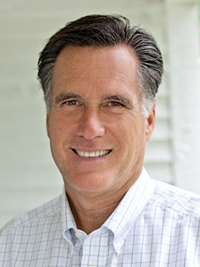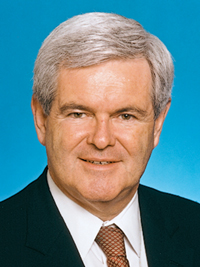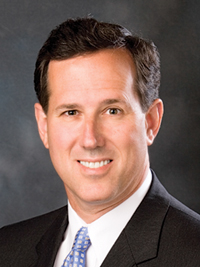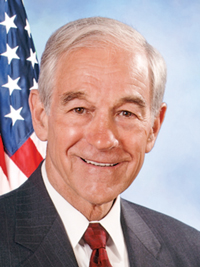DR. ROGER H. BEZDEK, Contributing Editor, Washington
The U.S. Presidential election in November will have critical implications for the country’s energy policies. Here’s a review of the energy policies advocated by President Barack Obama, the Democratic party candidate running for re-election, and the four candidates currently campaigning in primary elections to win the Republican party nomination.
BARACK OBAMA
President Obama is expected to continue energy policies promoting clean energy to reduce U.S. oil dependence on imports while increasing environmental regulation in the aftermath of the Gulf oil spill, public concern over natural gas fracturing and the desire to regulate greenhouse gases (GHGs). In March 2011, he released a “blueprint” for a secure energy future outlining these goals. The administration states that the U.S. is on track to double renewable energy generation above 2008 levels by 2012. In his 2011 State of the Union speech, Obama proposed that 80% of electricity production come from clean energy sources—nuclear, renewable, “clean coal” and natural gas—by 2035.
Under Obama, the environmental protection agency (EPA) has pursued regulation of GHGs, and his administration accelerated fuel economy standards of 39 mpg for cars and 30 mpg for light trucks—enacted in the 2007 energy bill—and proposed more stringent standards (54 mpg for cars) by 2025. In 2010, Obama had announced opening more federal lands and coastal areas to oil production, but the Gulf oil spill led to restricted drilling permitting, stricter safety standards and a restructuring of oversight agencies. Obama advocates eliminating tax breaks for oil and gas companies, which he contends will achieve $41 billion in savings.
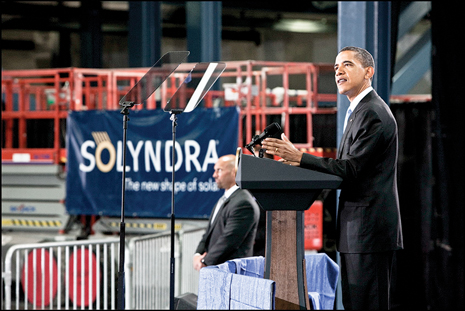 |
| President Barack Obama has called for the repeal of oil and gas industry tax breaks in favor of tax credits for renewable energy. |
|
REPUBLICAN CANDIDATES
All Republican candidates advocate energy policies very different than President Obama’s: They favor expanded oil and gas drilling, relaxed environmental constraints and deregulation, and all oppose GHG controls. Below, I briefly summarize the positions of four major candidates: Mitt Romney, Newt Gingrich, Ron Paul and Rick Santorum.
Mitt Romney. Former Massachusetts governor Romney emphasizes “significant regulatory reform,” increased domestic production and R&D. He proposes a new EPA regulatory framework to “preserve environmental gains without paralyzing industry.” Romney supports ethanol subsidies, stating that “ethanol is an important part of our energy solution for this country.” He is critical of Obama’s green jobs strategy and contends that the traditional energy sector—oil, gas, coal and nuclear—has “remarkable job-creating potential.” Romney advocates increasing domestic fossil fuel production, including shale gas, and partnering with Canada and Mexico to develop these resources. He criticizes Obama’s position on the Keystone XL pipeline and the offshore drilling moratorium following the 2010 oil spill: “A Romney administration will pave the way for construction of additional pipelines that can accommodate the growth in Canadian supply of oil and natural gas in the coming years.”
Newt Gingrich. The former U.S. House of Representatives speaker has a six-point energy plan that removes “bureaucratic and legal obstacles” to oil and natural gas development, finances clean energy research with oil and gas royalties, and ends the ban on shale oil development in the West. Gingrich would replace the EPA with an “Environmental Solutions Agency” that uses incentives and cooperation “to achieve better environmental outcomes while considering the impact of federal environmental policies on job creation and the cost of energy.” He supports all energy subsidies, including ethanol: “We decided it was better for money to go to Iowa than to Iran, better for money to go to South Dakota than to Saudi Arabia.”
Ron Paul. The U.S. House Representative from Texas would focus on “free market” energy solutions. He contends that federal “regulations, corporate subsidies and excessive taxation have increased energy prices, distorted the market and resulted in government bureaucrats picking “winners and losers.” Paul would repeal regulations impeding energy development and would lower energy taxes. He contends that reducing U.S. dependence on foreign oil will simplify U.S. foreign policy and improve the “anemic economy at home.” He opposes energy subsidies, but he supports tax credits and opposes ethanol mandates, which he characterizes as “corporate welfare for big agriculture.” Following the Gulf oil spill, Paul criticized the federal cap on spill liability, saying the burden should not be on taxpayers: “If accidents continue to be handled this way, it is easy to understand why so many see more cost than benefit to offshore drilling.”
Rick Santorum. The former U.S. Senator from Pennsylvania favors “an all-of-the-above energy policy that uses oil, natural gas, coal and nuclear energy to power our economy and empower the American worker.” Santorum advocates expanding oil and natural gas development: “We will open up energy in America, whether it’s ANWR, whether its coal mining, whether it’s drilling, we will have a free market of energy production. And we will lead the world, and we will have stable, long-term energy prices.” Santorum would end all energy subsidies, including ethanol, and opposes incentives for “different forms of energy that the government supports.”
FRACING REGS
In December 2011, the EPA determined that chemicals from fracing had polluted groundwater in Wyoming. This represents the first time in the intense debate over fracing that the EPA has drawn such a connection, which has long been claimed by environmentalists. The EPA found that groundwater in an aquifer around Pavillion, Wyoming, contained “compounds likely associated with gas production practices, including hydraulic fracturing.” The EPA constructed wells to test water quality in the Wyoming aquifer, near where natural gas firm Encana had drilled and found synthetic chemicals associated with the fracing process, and high methane levels and benzene concentrations “well above” the Safe Drinking Water Act standards. As a precaution, the U.S. Department of Health and Human Services advised local residents to use alternative sources of water for drinking and cooking and to use ventilation when showering. Critics of fracing quickly endorsed the EPA’s finding, and the Natural Resources Defense Council stated that EPA’s report “validates things Americans all over the country have been saying for years.”
Encana disputed the finding and stated that concerns about the pollution of drinking water “are not borne out by the facts.” It contends that the EPA’s test wells were far below the depth of drinking water wells: “At a depth where you would expect to find hydrocarbons, they found hydrocarbons. In drinking wells, they found no impacts due to oil and gas.” Encana and the state of Wyoming have conducted extensive testing and have never found contaminants in these drinking water wells.
In recent years, production of shale gas using fracing has spread throughout much of the U.S., but it has generated environmental concerns, especially its potential impact on groundwater. More than one-third of all U.S. natural gas drilling now uses fracing, and that percentage is increasing. There is much at risk: A major U.S. energy technology, many billions of dollars of investment, hundreds of thousands of jobs, and future U.S. natural gas supplies. Thus, if valid, this EPA study could produce a major energy paradigm shift.
IS EPA’S STUDY VALID?
The EPA was careful to note that its findings “are specific to Pavillion” and are not applicable to other fracing projects. This is the first major study that detected linkage between fracing and groundwater pollution, and the EPA draft has not been independently peer-reviewed. Many have criticized the study, which even the Wyoming governor called “scientifically questionable.”
There are good reasons for skepticism:
-
USGS has detected organic chemicals in the well water in Pavillion for at least 50 years, long before fracing began.
-
The study concedes that “detections in drinking water wells are generally below established health and safety standards.”
-
The pollution linked to fracing was found in deep “water monitoring wells” and not the shallower drinking wells. It is unclear if pollution in these deeper wells affected the drinking wells.
-
To the extent that drilling chemicals were detected in monitoring wells, EPA admits this may result from “legacy pits,” which are old wells drilled many years before fracing was employed.
-
The design of Pavillion’s old wells allows seepage into the water supply, and safer well construction of the kind currently practiced might have prevented contaminants from leaking into the water supply.
-
The fracing in Pavillion occurs in unusually shallow wells of less than 1,000 ft, whereas most fracing occurs at depths of 10,000 ft or more, far below drinking water wells.
-
Pavillion’s drilling conditions differ from other areas of the country, and the Wyoming finding may not be relevant to other U.S. fracing operations.
Nevertheless, the potential impact of the EPA finding is immense. Its reception in Congress is critical, because fracing was removed from EPA’s jurisdiction by the 2005 Energy Policy Act. Many activists desire EPA jurisdiction over fracing—something the industry vehemently opposes.
KEYSTONE FOLLIES, ACT 2
As noted in my previous column, a favorable decision on the Keystone XL pipeline—a 700-mi pipeline carrying oil sands crude from Alberta, Canada, to the Gulf Coast refineries—was expected by Dec. 31, 2011. However, in November, the U.S. State Department ordered a review of alternate routes to avoid an environmentally sensitive region of Nebraska, and this would have delayed the decision until 2013. While deemed nonpolitical, it was the latest in a series of administration decisions deferring controversial energy and environmental issues beyond November’s presidential election to try to avoid criticism from opposing interests—industry advocates and environmentalists, and to find a political middle ground. For example, President Obama has also delayed a review of the U.S. smog standard until 2013 and delayed offshore oil lease sales in the Arctic (see below).
The decision pleased few: Industry fears that it jeopardizes the pipeline; environmentalists fear that XL will be approved after the election; and the consensus is that the delay was purely political. In the meantime, TransCanada is considering rerouting the pipeline to neutralize opposition (from Republicans!) in Nebraska. However, the dust had hardly settled before the pipeline decision was front and center again. As part of last-minute compromise legislation on a two-month payroll tax-cut extension, President Obama was required to make a decision by Feb. 21.
However, the Republicans’ tactic may have backfired: On January 18, Obama rejected the pipeline’s permit application. Politically, a pre-election decision for or against the pipeline was a losing proposition for the President. While Obama’s labor union supporters were supportive of the pipeline, his environmental backers were vehemently opposed. Nevertheless, both proponents and foes of the pipeline agree that the fight did not end with Obama’s decision, and the question is how the battle will be waged in the coming months. Congressional Republicans vow to again seek legislation to clear the path for the controversial pipeline, while environmental groups say they will fight any new Keystone proposals. TransCanada said it will not only file a new permit application, but also might pursue a truncated system within U.S. borders that would not require State Department approval. Thus, the issue remains unresolved, so stay tuned.
E&P ACCESS
In November, the Obama administration proposed a five-year plan to open six areas for oil and gas drilling, including unleased portions of the Gulf of Mexico and Alaska’s coast, an approach that Secretary of the Interior Salazar stated “will help us continue to reduce our dependence on foreign oil and create jobs here at home.” Salazar proposed 15 lease sales in 2012–2017, with five annual lease sales in the western Gulf beginning in the fall of 2012, and sales in the central Gulf starting in spring 2013.
Two lease sales will be held in 2014 and 2016 for tracts in the eastern Gulf that are not currently under a Congressionally-mandated leasing moratorium, set to expire in 2022. Three more sales would be scheduled in “frontier areas” off Alaska’s coast, including the Beaufort and Chukchi Seas and the Cook Inlet. Salazar stated that the Alaskan lease sales, the first since 2008, would balance a need for developing energy resources with environmental and cultural considerations.
The Interior Department is required, under the Outer Continental Shelf Lands Act, to prepare a five-year schedule of oil and gas lease sales, indicating the size, timing and location of proposed leasing activity while addressing economic and environmental issues. The proposal does not change Obama’s 2010 decision to cancel plans for drilling off the eastern Gulf Coast and portions of the Atlantic Coast, precipitated by the Gulf oil spill. This proposal has generated criticism from oil and gas industry advocates and from environmentalists opposed to E&P activities. Republican lawmakers criticize the lack of drilling allowed off the Atlantic and Pacific coasts, which they contend would create jobs and reduce U.S. dependence on foreign oil. “It’s a good sign that Secretary Salazar finally produced a five-year plan, but unfortunately it’s a huge missed opportunity,” U.S. Senator David Vitter (Republican-La.) said in a statement. House Natural Resources Committee Chairman, Rep. Doc Hastings, (Republican-Wash.) stated that by excluding new areas off the Atlantic, Pacific and Arctic coasts, the Obama administration was continuing to “re-impose an offshore drilling moratorium.”
Similar criticisms came from the oil and gas industry. “This ill-conceived plan leaves us looking in the same areas we have looked for over a generation and would cast our energy reliability and security lot to the whims of other, often unfriendly nations,” the National Ocean Industries Association said.
While the American Petroleum Institute called the proposal “a good first step,” it urged the Obama administration “to reconsider its decision to exclude other offshore regions” from lease sales until 2017. API research found that increasing access to domestic sources of oil and natural gas would, by 2025, create 20,000 jobs, provide $150 billion in tax, royalty and other revenues, and increase domestic production by 4 MMboed.
However, environmentalists criticized the plan for being overly generous to the industry, and they oppose offshore development in the Arctic. “The administration’s new five-year plan is good news for Atlantic coastal states, especially Virginia and Florida. However, the Arctic and the Gulf are still in harm’s way,” according to Oceana, an international organization for ocean conservation. Shell Oil plans to begin exploratory drilling off the Alaska coast this summer. 
THE AUTHOR
|
|
DR. ROGER BEZDEK is an internationally recognized energy analyst and president of Management Information Services, Inc., in Washington D.C. He has 30 years of experience in research and management in the energy, utility, environmental and regulatory areas, serving in private industry, academia, and the federal government. He has served as Special Adviser on Energy in the Office of the Secretary of the Treasury, as U.S. energy delegate to the European Community and to the North Atlantic Treaty Organization, and as a consultant to the White House, federal and state government agencies, and various corporations and research organizations. His most recent book, The Impending World Energy Mess, was published in October 2010. / RBEZDEK@MISI-NET.COM
|
| |
| |
| |
| |
|


